#celtic history
Explore tagged Tumblr posts
Text
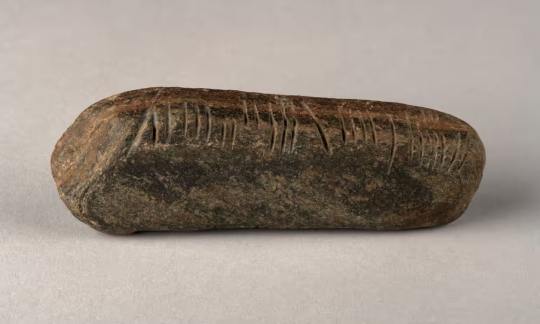
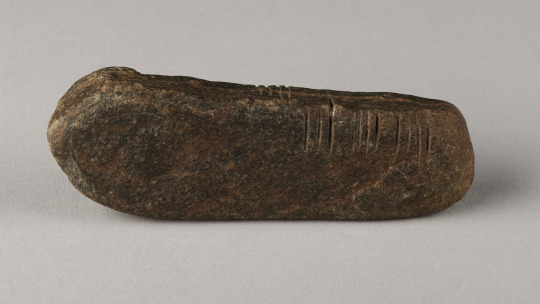
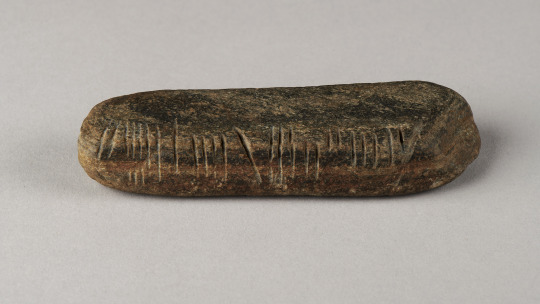
Stone With 1,600-Year-Old Irish Inscription Found in English Garden
A geography teacher, Graham Senior, stumbled across a rock with mysterious incisions while tidying his overgrown garden in Coventry, England. The discovery of a small stone carved with an early form of Celtic script has caused excitement among archaeologists.
The rectangular sandstone rock was found by Graham Senior in Coventry during lockdown in 2020 while he was weeding, but its true value was only recently understood.
The 11-centimeter-long and 139-gram rectangular sandstone rock had cryptic inscriptions on it that suggested a history spanning over 1,600 years, all written in the mysterious Ogham alphabet.
Ogham is an early medieval alphabet used to write the Archaic Irish language from the 4th to the 6th century and Old Irish from the 6th to the 9th century. It is usually found carved on stones in Ireland, Wales, and western Britain. It was the first written language in Ireland. The majority of the 400 or so known inscriptions from the Archaic Irish period are family name pillars that were built to announce land ownership.
Ogham is an extremely unique writing system among all writing systems, with lines arranged in groups of one to five only. The stones provide insight into the Irish language before the use of the Latin insular script.
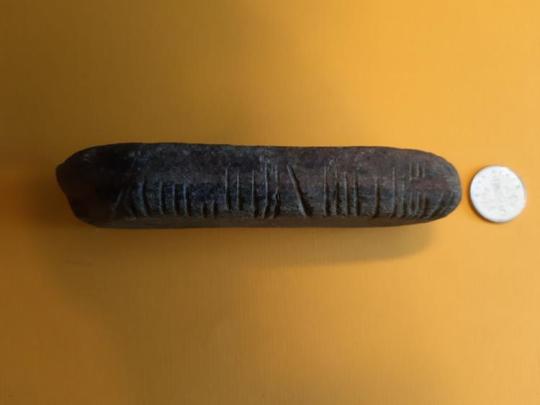
Finds liaison officer for the Birmingham Museums Trust, Teresa Gilmore, told RTÉ’s Morning Ireland that the discovery on an Ogham stone in the English midlands was a rare find.
“These finds do not turn up in the midlands. The bulk of Ogham inscriptions are found over in Ireland,” she said.
Professor Katherine Forsyth of Celtic Studies at the University of Glasgow conducted additional research that shed more light on the stone’s provenance. Her findings point to a period suggesting a timeframe ranging from the fifth to sixth centuries, with the possibility of an even earlier date in the fourth century.
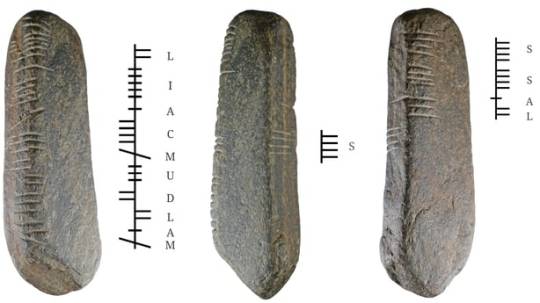
The stone is inscribed on three of its four sides. The inscription on the stone, “Maldumcail/S/ Lass,” puzzled researchers, with interpretations pointing towards a version of the personal name Mael Dumcail, but the meaning of the S and LASS is unclear. Given the usual purpose and significance of ogham stones, it may be a location reference.
Theories regarding the origins of the stone abound, with speculations ranging from migration patterns to the presence of early medieval monasteries in the region.
The rock will be displayed at the Herbert Art Gallery and Museum in Coventry, to which Senior has donated it permanently. It will feature in the forthcoming Collecting Coventry exhibition, which opens on 11 May.
By Oguz Kayra.
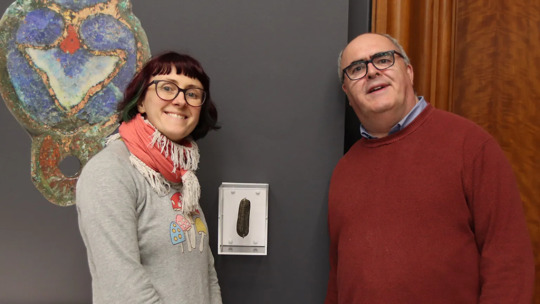
#Stone With 1600-Year-Old Irish Inscription Found in English Garden#Coventry England#Celtic script#sandstone rock had cryptic inscriptions#Ogham alphabet#ancient artifacts#archeology#archeolgst#history#history news#ancient history#ancient culture#ancient civilizations#celtic history#irish mythology#celtic art
678 notes
·
View notes
Text

fjorntheskald.com - Learn Norse, Celtic, and Medieval History
Hwæt! From the ashes of Fjorn’s Hall comes a new website for an old skáld—though that’s perhaps not the best phrasing because I don’t think I’m that old? Anyway…
I’ve rummaged through my archives, selected the ‘best’ stuffs, and plastered in on a new website. Most of the content is actually here on Tumblr, but I find it much easier to, well, find on the website. As of writing this, here’s what you’ll find there:
161 posts (230k words)
10 old podcast episodes (5.5 hours)
6 digital maps
7 academic papers (links to Academia.edu)
It’s pretty nice, I think? But it’ll need tweaking over time. This is just the (new) beginning. My next big plan is to reintroduce content from Fjorn’s Hall, which used to be blocked behind a paywall. I’m not interested in that anymore, so it’ll all be free and stay that way. That means we have ~45 videos coming over the next 45 weeks (because I’ll do 1 at a time to pace myself). Those videos will be posted on my YouTube channel but also shared to the website. So yeah, something to look forward to maybe? I hope so.
Let me know what you think. If something is janky, incorrect, or otherwise problematic…please let me know. I’m not perfect.
Many thanks for all the support and love over the years. I’ve had my ups and downs, but I’m very happy to be back :)
— fjörn
216 notes
·
View notes
Text
"Women in Britain 2,000 years ago appear to have passed on land and wealth to daughters not sons as communities were built around women's blood lines, according to new research.
Skeletons unearthed in Dorset contained DNA evidence that Celtic men moved to live with their wives' families and communities.
Scientists found evidence of a whole community built around the female line of a family over generations, probably originating with one woman.
"This points to an Iron Age society in Britain where women wielded quite a lot of influence and could shape its trajectory in many ways," says Dr Lara Cassidy at Trinity College, Dublin, lead author of the research."
It is the first time this evidence of communities being built around women has been documented in ancient European history.
The scientists believe that the communities also invested a lot in their daughters as they would probably inherit their mother's status.
"It's relatively rare in modern societies, but this might not always have been the case," says Dr Cassidy.
The team found evidence that it happened in numerous places in Britain, suggesting it was widespread.
The communities analysed lived around the same time as Boudica, the warrior Queen who led a rebellion against Roman invaders in East Anglia around AD 61."
#history#women in history#women's history#celts#celtic women#celtic history#british history#england#english history#iron age#ancient history#antiquity#1st century
85 notes
·
View notes
Text
The Otherworld, Fea/Fey and what little we know about Celtic mythology

Okay. I was now asked more than once about this. Which is fair. What is the Otherworld? I have noted this word more than once in regard to Maria and her magic - and if you have read any of my writing on Castlevania you might have stumbled across the word as well, as I reference it fairly often there as well.
If you are one of those five people who came originally from Twitter to follow me here, you might also know that a friend and I work on a comic called Otherworldly. So, let me talk about the Otherworld.
The Celtic Otherworld
The general concept and name of the Otherworld comes from the celtic mythology. Once more we know most about it from the Gaelic mythology, because most of the oral tradition that has survived is from the Scots and the Irish. And you might even have heard at some point of Tír na nÓg, which was one of the names for the Gaelic variation of this myth. If you were at any point a fan of Lord of the Rings you might also be aware of the concept, despite Tolkien using another name for it.
Generally speaking the Otherworld is a world of eternal youth and beauty, in which the fae/fey, as well as the gods of this religion tend to live. But in some cases humans wander into the Otherworld as well. Maybe because they get invited into it by a fae of some variation of sidhe, or just because they get lost. In those cases we might have stories in which children get lost in the forest and years later stumble out of the forest not having aged a single day.
Something that is maybe specific interesting for Maria: The Gaulic mythology (so the one of the French celts) actually said, there were two Otherworlds: The White World and the Black World. The White World was a sort of heaven, the Black World a sort of hell - even though that is obviously just once more interpreting it through a Christian lense.
Generally speaking this was less of an afterlife. While the souls of the deceased would generally pass through the otherworld, most of them would then go on (possibly for reincarnation). Though we have some stories of heroes that remain in the Otherworld and become sorts of gods.
The Otherworld as a General Concept
This is the moment where I will once again talk about Indo-European mythology. As you might have heard: Pretty much all cultures that existed in Europe and around the Mediterranean and some part of Asia go back to one culture that originally lived in the area that is today's Ukraine, which in anthropology is called the Proto-Indo-European culture. And we are fairly certain, that the Otherworld at the very least goes back to the mythology that this culture has had - if not even further back, as similar concepts are even found outside of these connected cultures.
Basically, these cultures generally have a realm or parallel world in which the gods reside and at times all sorts of other paranormal creatures.
This is why some authors, like me, use this parallel in their writing. Of course we are well aware that anthropoligically speaking these parallels are there, because the cultures have the same root and have influenced each other. But of course, as a fantasy writer it is hard to not look at it and go: "Well, what if all these cultures have this concept because it is real?!"
Fae/Fey
Lastly we should talk about the Fae/Fey. Again, the wording goes back to the Celts. Fae/Fey is generally a word that is often used today as "fairy", though technically the fae in the mythology are usually not little humanoids with wings. Mainly they seem to have been a sort of spirit-like being, some of which showed as humans with otherworldly beauty and eternal youth. This is mainly where the elves in fantasy come from. Some could also appear as both animals or monsters of sorts.
The general thought is, that they probably anthropologically speaking fae probably go back to a spiritual religion, in which nature spirits were revered in different ways - and then got personified partly as fae or gods.
And if we are talking fantasy writers once more: Given those parallels with the Otherworld, especially Urban Fantasy does this little trick quite often, where pretty much all spiritual beings from all sorts of religions just get qualified as "fae", no matter from what culture they come. So Yokai from Shinto might also qualify as fae in this way of looking at it.
And that in the end brings us back to Maria, whose familiars obviously were originally based in East Asian mythology, while the way she summons them clearly is more linked to the celtic culture.
It will be really interesting to see (if the Netflix algorithm decided that it would be worth it for Netflix to let Powerhouse make another season) how this is going to tie back to Maria's backstory eventually.
#castlevania#castlevania netflix#castlevania nocturne#maria renard#celtic mythology#celtic history#indo european#mythology#anthropology#archeology#otherworld#fae
31 notes
·
View notes
Text
Recommended Beginner Resources
**I don’t consider myself an expert, these are books that I personally enjoyed
Wild Magic by Danu Forest
This is a great book for those just beginning their exploration into a Celtic path. There are traditions, cultural aspects, deities, and other topics covered in this book.
Morgan Daimler
Many of Morgan Daimler’s works are very beginner-friendly, and overall pleasant to read. Her writing style makes historical information a bit easier to process, and her insight is a nice touch.
True Magick by Amber K
Definitely a personal favorite, Amber provides an interesting perspective on many beginner topics, specifically on reincarnation in the witchcraft/pagan sphere. This is a Wiccan-centered text, but is a good foundational piece for any practice.
Buckland’s Complete Book of Witchcraft
Buckland is not one of my favorite authors, but this book in particular was very engaging due to its incorporating workbook pages after each chapter. This is a great way to test your knowledge on previously covered information as you go along in the book and is very helpful for retaining what you’ve learned.
Wild Witchcraft by Rebecca Beyer
Again, not inherently Celtic, but a nice piece on nature-centered practice with a focus on spirits of place rather than deities (as many books tend to be).
Earth Witch by Britton Boyd
I was intrigued by this book after hearing Britton speak on a podcast, and I’m glad I read it! Again, not focused on Celtic practice, but includes thought-provoking philosophical perspective and exercises for becoming closer with the land and its spirits.
Scott Cunningham
Cunningham is a household favorite for many practitioners. His works are broad yet thorough, and applicable to many practices despite being Garderian at their cores.
Scottish Witchcraft & Magick by Raymond Buckland
Again, not my favorite author, but this brief collection of practices can be a good introduction to aspects of Scottish witchcraft. This book is based on the information of one major source, Aidan Breac of the PectiWita tradition, with additional historical references throughout. However, Buckland often inputs his own Gardnerian perspective, which is generally unhelpful in the context of Scottish tradition.
Year of the Witch by Temperance Alden
This book is a nice introduction to the annual holidays. Each chapter focuses on a sabbat/holiday, along with its aspects, symbolism, practices, etc, as a bit of a deeper dive compared to what the average beginner book covers. (Again, Wicca-based, but still informative.)
The Taín
The epic folktale of the Taín Bó Cúailnge is a good historical reference for those just starting on their Celtic path. There is introduction to Irish culture, language, deities, and other famous historical characters that provide insight into what the Celtic tradition is, why it is this way, and how we can learn from the past.
The Mabinogion
This Welsh text consolidates folklore, legend, and history for a great introduction to Welsh customs and culture. Another great historical reference for beginners first starting to look through medieval sources.
sacred-texts.com
This website is a digital collection of historical references throughout the ages adapted for modern perusal. Many texts like the Táin, the Mabinogion, and other pieces of folklore can be found here for FREE! Donations are encouraged for database upkeep.
#celtic#folk witchcraft#witch community#witchblr#witchcraft#witches#green witch#witch#witch aesthetic#witchcore#folk witch#irish witchcraft#witch blog#pagan witch#traditional witchcraft#witches of tumblr#Scottish witchcraft#scottish folk magic#celtic paganism#celtic folklore#ancient celts#resources#references#celtic history#cunning folk#folk practitioner#folk magic#irish folk magic#folklore#scottish folklore
22 notes
·
View notes
Text
youtube
Why did Celts of the British Isles build over 4000 hill forts during the Iron Age? The answer may have something to do with the conflict between those Bronze Age cowboys who maintained traditional pastoralist transhumance lifestyles, and those in the forts who depended more on arable farming. This can also explain why British Celts were the most lactose tolerant people on Earth at that time. In this documentary I visited Barbury Castle in Wiltshire, Castle an Dinas in Cornwall and several other magnificent Iron Age hill forts.
#hill fort#celtic paganism#british history#welsh history#iron age#roundhouse#brythonic#brythonic polytheism#lactose intolerance#history documentary#ancient history#ancient britain#celtic britain#celtic history#Youtube
38 notes
·
View notes
Text
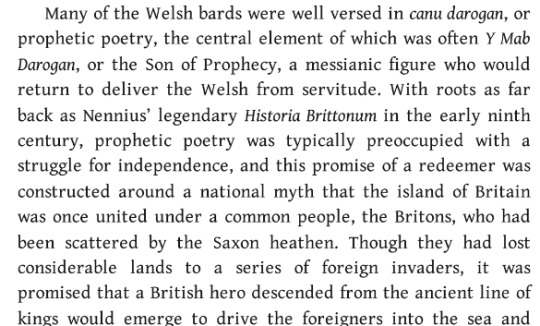

From Son of Prophecy: The Rise of Henry Tudor, by Nathen Amin
#welsh bards#mab darogan#welsh history#welsh culture#celtic culture#celtic history#british history#canu darogan#prophetic bardism#nennius
14 notes
·
View notes
Text
I was thinking about how allot of legends of Saint Patrick are basically him demonstrating that the Christian god is more powerful than local pagan deities to get converts and it made me think of like anime community power scalers and it made me think of these memes to create as hypothetical memes in early Middle Ages Irish social media:
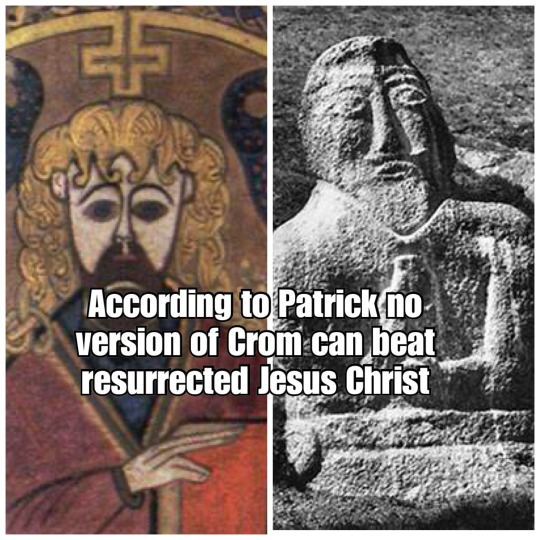

I apologize if there’s anything wrong with the Irish language one colonialism did a number on it even in Ireland so it didn’t exactly survive in the diaspora for me so I used google translate 😅
#shut up alex#personal#celtic#irish american#irish#ireland#saint patrick’s day#saint patrick#history#history memes#irish history#irish history memes#irish culture#gaelic#celtic history#my memes#homemade memes#original memes
40 notes
·
View notes
Text
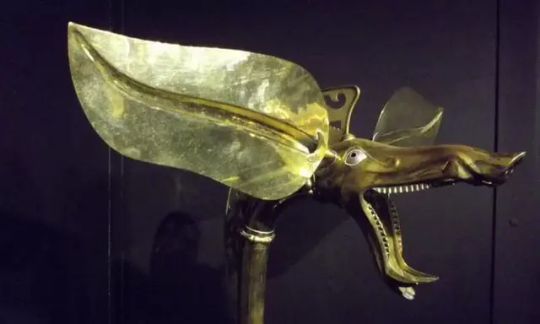
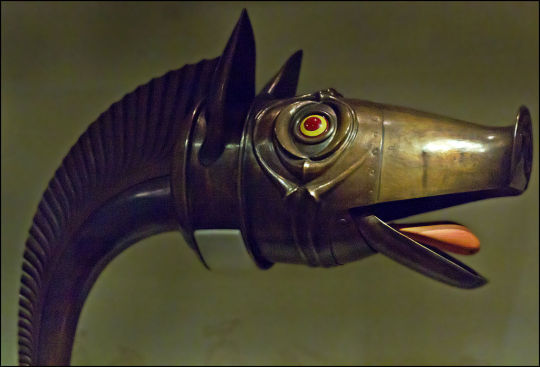
The 'Carnyx' Nightmare of the Roman Soldiers
The Carnyx was a brass musical instrument used as a psychological weapon of war by the ancient Celts between 300 BC and 200AD in western and central Europe and beyond.
The carnyx was once widespread throughout much of Europe, although only a dozen or so fragments are known to us.
It was carried by bands of Celtic mercenaries; it was present at the attack on the Greek sanctuary at Delphi in 279 BC; it defied Julius Caesar in Gaul; and it faced Claudius when he invaded Britain. They are even shown on a Buddhist sculpture in India, proof of the far-flung connections of the Iron Age world.
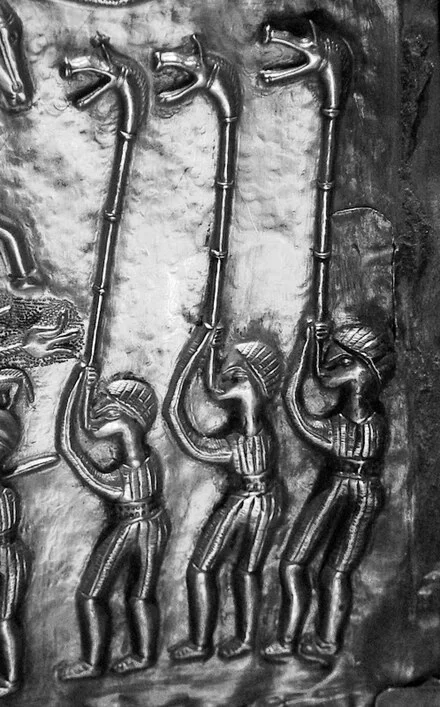
However, they were not only used by the Celts; they were also used by the Dacians in modern Romania. The term “Celtic” is a complicated one. The concept of a pan-European Celtic culture is a myth; rather, aspects of art and technology were shared across vast distances by diverse cultures. The carnyx was one example of this.
A 12-foot-long, thin bronze tube with right-angle bends on both ends made up the carnyx. The lower end ended in a mouthpiece, and the upper end flared out into a bell that was usually decorated to look like a wild boar’s had. Historians believe it had a tongue that flapped up and down, increasing the noise made by the instrument. The carnyx was played upright so that the boar’s head bell protruded well above the warriors’ heads. Its primary goal was to create more noise and confusion on the battlefield.


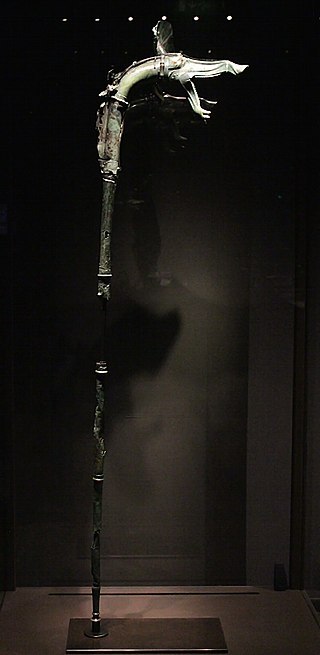
The Greek historian Polybius (206-126BC) was so impressed by the clamor of the Gallic army and the sound of the carnyx, he observed that “there were countless trumpeters and horn blowers and since the whole army was shouting its war cries at the same time there was such a confused sound that the noise seemed to come not only from the trumpeters and the soldiers but also from the countryside which was joining in the echo”.
And the Roman historian Diodorus Siculus wrote, “Their trumpets are also of a peculiar and barbaric kind which produce a harsh, reverberating sound suitable to the confusion of battle.”
Archaeologists discovered a hoard of ritually destroyed weapons in 2004, including a dozen swords, scabbards, spearheads, a shield, bronze helmets, an iron helmet shaped like a swan, a cauldron, animal remains, and seven carnyces. Before the Tintignac discovery, the remains of only five actual carnyces had been found.
The finest was unearthed in Deskford, Scotland in 1816. The Deskford carnyx only has the boar’s head bell and is missing the mane, tongue, and tubing. Images of Carnyx players have been found as well. A Roman denarius, dating from 48 BC bears a representation of a Carnyx. Three carnyx players are featured prominently on the Gundestrup Cauldron, which was found in a Danish peat bog.
One of the seven found at Tintignac, on the other hand, was almost entirely complete. The Tintignac Carnyx was broken into 40 pieces. When puzzled back together, it was found to be just an inch short of six feet long with a single missing section of the tube. The bell was a boar’s head with protruding tusks and large pointed ears. Once restored, the Tintignac Carnyx proved to be the first virtually complete carnyx ever found.
By Leman Altuntaş.
Music video by John Kenny.
#The Carnyx#The 'Carnyx' Nightmare of the Roman Soldiers#Iron Age war trumpet#ancient artifacts#archeology#archeolgst#history#history news#ancient culture#ancient civilizations#celtic mythology#celtic history#roman history#roman empire#roman legion
3K notes
·
View notes
Text
Trip to Britain 325BC

Pytheas of Massalia was a Greek geographer, explorer and astronomer from the Greek colony of Massalia. He made a voyage of exploration to Northern Europe in about 325 BC, but his account of it, known widely in antiquity, has not survived and is now known only through the writings of others. On this voyage, he visited the British Isles. This is the first time Britain is mentioned in any historical sources. The map above was created from his description in the thirteenth century. Apparently he travelled extensively around the 'isles', making notes of what he saw, and also provided what may be the earliest written report of Stonehenge. He names the promontory of Kantion (land of the Cantii - modern Kent), the promontory of Belerion (land of the Cornovii - modern Cornwall), and Orkas (the Orkneys). To ascertain these names he must have visited each location, and probably many others besides. Belerion, he recorded, was home to a civilised people who were especially hospitable to strangers, apparently due to their dealings with foreign merchants who were involved in the tin trade. His name for the British Isles themselves the 'Prettanic isles is close to the Welsh, Prydain (Britain). The spelling of 'Prettanic' can vary. It can be shown with one 't' or two, and the final 'k' sound can either be written as a 'k' or as a 'c'. This is due only to different alphabets used by Romans and Greeks. Pretan to the Celts became Britannia to the Romans.
6 notes
·
View notes
Text
Boudica irl died shortly afterwards after leading her tribe people to resist Roman's colonization.
In the DD universe a fitting parallel end for her would be her leading all the mercs and townsfolks of Hamlet to revolt against Vvulf's invasion, but herself bleeds out or died during the battle. 🍷
#darkest dungeon#dd hellion#dd boudica#celtic history#I'm def adding this to my long fic if I'd ever write one
4 notes
·
View notes
Text
Everyone is sleeping on the Boudicca Dreaming series. Read these books. They're incredible (and queer!)
#boudicca#manda scott#queer history#historical fiction#books#book#series#book review#celtic#celtic history#boudica
4 notes
·
View notes
Text
Celtic Customs: Hair
by autumn sierra
I’d like to share a bit about the significance of hair in Celtic culture, specifically how it pertains to myself. I wouldn’t necessarily call this a folk practice, just a general custom. (This isn’t an article just a general post based on a prompt.)

In ancient times, the Celts (be they Irish or Scottish or Welsh, etc) were very well known for their grooming and cleanliness. They were the ones that inspired the use of soap for the Romans and Anglo-saxons. With this, there was an incredible amount of importance placed on one’s hair.

Many Celts carried ivory or wooden combs to maintain their hair, preventmats, and washed it regularly. They developed intricate braids along with normal three strand plaits in order to keep their hair long and healthy. Later on, it became popular for Irish men in particular to cut their hair into a bowl shape in the front and short in the back—the “glib”—but for the longest time in history, they were most known for their long, well kept hair.

It’s an ongoing debate whether the Celts incorporated the use of locs in their customs. In some cases, I would argue that yes, locs were present due to lack of resources among the lower class. However, it wasn’t the standard as many Irish and Scottish peoples regularly bathed and groomed themselves. Some may have received “fairy locs”: matted and woven sections of hair made by the mischievous sìthe.

(This is not cause for the accusation of cultural appropriation, as there are many types of hair patterns from 1a-4C, and such ideas didn’t even exist in early centuries. Those with curly, kinky, or coily textures are more likely to have naturally occurring locs which can be maintained through what we now know as crocheting, and twisting, etc. Certain curl patterns are not exclusive to the African, Baye Fall, Rasta, and other communities considered black. For these reasons, locs—not necessarily “dreads”, since there is cultural significance there—have also been worn by Indigenous American (and possibly Inuit) peoples, Aztecs, Minoans, the Polish, Indigenous Australians, Tibetans, and Indians throughout history.)

Long hair is said to be a representation of spiritual growth, connection to the self and the natural world. The head was considered the vessel in which the soul resides in ancient times, specifically in Celtic folklore. This is evidence for why warriors would take the heads of their enemies in battle, as a symbol of victory over another’s soul. (Quite brutal, indeed.)

My hair is also an insanely important part of my identity, and I’ve adopted similar practices of maintenance as my Celtic ancestors. I’m now recognized by family, friends, and coworkers for my hair’s length, vibrancy and shine. I’ve also realized some symbolism of plaits, the three strands representing the body, mind, and spirit. It’s great to meditate on the interconnectivity of these while braiding. I usually braid it like this, or keep it twisted into a bun or hair pin to keep it from matting in the breeze. Somehow, it seems the wind has become more enticed with tangling my hair as of late. Maybe the sìthe found their way to me only to tangle my hair!
#ireland#scotland#culture#customs#long hair#haircare#hair care#celtic#celtic history#history#irish history#scottish history#witchblr#witch#witchcraft#folk witchcraft
22 notes
·
View notes
Text
working on my undergrad thesis. on pre-christian celtic history. in ireland. if i have to read one more greco-roman account of celts i will scream. someone get me a time machine for fucks sake
2 notes
·
View notes
Text



Lan-Kern Trilogy by Peter Tremayne
Cover art by Tim White
Methuen, 1980-1983
Fires of Lan-Kern (1980)
Returning from a Polar trip, the British landscape that greeted the crew of the nuclear submarine carrying botanist Frank Dryden, was completely devoid of life. The disorientated crew searched the coastline in vain for life - only ruins and mutated animals remained. Then the overworked nuclear drive exploded, leaving Dryden alone on the forbidding Cornish Peninsula.
Forced to survive in an alien landscape, Dryden was befriended by the Celtic tribe of Lan0Howlek. Soon he was drawn into their bloody battle with the evil followers of the witch, Nelferch, and underwent the painful and terrifying initiation rites of a Druidic healer.
In the once and future land of Lan-Kern, Dryden began his search for the holy relic, An Kevryn - the secret key to the Universe...
The Destroyers of Lan-Kern (1982)
Lan-Kern, that myserioius land of forests and coast, strange creatures and dangerous men, once known as Cornwall... Through its perilous landscape two men pursue a deadly rivalry. One is Yaghus, once Frank Dryden. The other is Cador, his arch-enemy. But stalking both of them and Lan-Kern itself is a greater threat from the bowels of the earth...
The Buccaneers of Lan-Kern (1983)
In pursuit of the drewyths ancient relic An Kevryn, reputed to be the key to the universe, Yaghus the Healer, once Frank Dryden, continues his perilous journey through the once and future land of Lan-Kern. Aided by the peace-loving natives of Mon, Dryden and his two friends successfully reach the savage kingdom of their enemy, Conla, the morlader buccaneer. But success turns to despair when evil forces conspire against their chances of ever achieving their goal...
#book cover art#cover illustration#cover art#peter tremayne#lan-kern#fires of lan-kern#destroyers of lan-kern#buccaneers of lan-kern#80s sci fi#80s fantasy#tim white#science fantasy#sci fi#fantasy#celtic fantasy#celtic history#sci fi fantasy#sci fi and fantasy
4 notes
·
View notes
Text
“When love awakens in your life, in the night of your heart, it is like the dawn breaking within you. Where before there was anonymity, now there is intimacy; where before there was fear, now there is courage; where before in your life there was awkwardness, now there is a rhythm of grace and gracefulness; where before you used to be jagged, now you are elegant and in rhythm with your self. When love awakens in your life, it is like a rebirth, a new beginning.”
― John O'Donohue, Anam Cara: A Book of Celtic Wisdom

2 notes
·
View notes